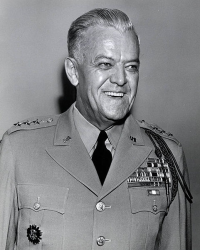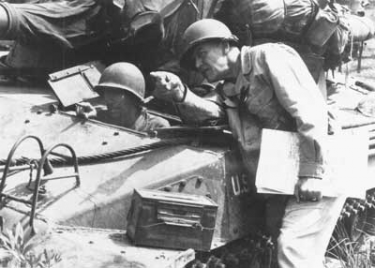
 |
|
|
||
|
Andrew Davis Bruce |
||||
|
Engagements: • World War I (1914 - 1918)• World War II (1941 - 1945) |
||||
| Biography: | ||||
|
Andrew Davis Bruce Andrew Davis Bruce was born on 14 September 1894 in St. Louis, MO, the son of John Logan and Martha Washington Smith Bruce. His family moved to Texas when he was a child. After finishing high school, Bruce attended the Agricultural and Mechanical College of Texas, now known as Texas A&M University, where he was required to be a member of the Corps of Cadets and undergo military training. In 1916, Bruce earned a doctorate of laws from Texas A&M. World War I Shortly after his graduation, the U.S. entered World War I. In June 1917, Bruce joined the U.S. Army and was commissioned as a Second Lieutenant. He attended the First Officers Training Camp at Leon Springs, TX. After completing his training, he was sent to France as part of the 2nd Infantry Division's 5th Machine Gun Battalion. He was in combat in France in the Troyon Sector near Verdun; in the Aisne Defensive operation near Chateau Thierry; the Aisne-Marne offensive at Soissons; the fighting at St. Mihiel; and the Meuse-Argonne offensive at Blanc Mont. Following the fighting in France, he hiked with his Division into Germany to be part of the occupation force. At the relatively young age of 24, Bruce achieved the temporary rank of Lieutenant Colonel. Between the World Wars In 1920, Bruce married Roberta Linnell Kennedy. The couple made their home in Bryan, TX, near Texas A&M, and Bruce taught Military Science and Tactics at Allen Academy. They had three children. For the next two decades Bruce continued to serve in the Army. He served with the 33rd Infantry in Panama; participated in historical work at the Army War College; and served on the War Department General Staff revising textbooks on military doctrine. He also furthered his own knowledge of military tactics, attending the Infantry School, the Field Artillery School, the Command and General Staff College, the Army War College, and the Naval War College. World War II Following the U.S. entry into World War II, Brigadier General Bruce was assigned to organize a new tank destroyer center. He chose Killeen, TX, for the new camp, and named it Fort Hood for General John Bell Hood. On 9 September 1942 he was promoted to Major General. The following year he became Commander of the 77th Infantry Division. Under his leadership, the group participated in campaigns in Guam, Leyte, and Ryukyu. At Leyte, in the Philippines, the Division was responsible for taking Palompon, the last main port the Japanese held on the island. During the ten-day battle for that area of the island, from 21 December through 31 December 1944, the Division estimated that they had killed 5,779 Japanese soldiers and taken 29 prisoners, with only 17 Americans killed, 116 wounded, and 6 missing in action. For his service, the government of the Philippines later awarded him the Philippine Legion of Honor, the Philippine Liberation Medal, and the Presidential Unit Citation. In April 1945, the 77th Division was ordered to seize the island of Ie Shima in the Ryukyu islands so that the U.S. Army could use the island's airfields to support assaults on Okinawa and other islands in Japan. During the six-day battle to secure the island, 4,706 Japanese soldiers and civilians were killed, while 172 Americans were killed, 902 were wounded, and 46 were missing. During the battle, famed war correspondent Ernie Pyle was killed by a sniper. Bruce and his men buried Pyle on the island, later erecting a monument to him. Despite the fact that the Japanese had tried to destroy the airfields, Army engineers were able to have all taxiways and runways fully operational by mid-May. Post-War Service Following the surrender of Japan, MG Bruce served as the Military governor of Hokkaidō. In 1946, he was made Commander of the 7th Infantry Division in Korea. He returned to the U.S. in October 1947, and served as Deputy Army Commander of the Fourth Army stationed at Fort Sam Houston, TX. His primary responsibilities were to assist with the training activities of the ROTC, National Guard and Organized Reserve Corps of five states. In July 1951 Bruce was named as Commandant of the Armed Forces Staff College in Norfolk, VA. On 30 July 1951, he was promoted to Lieutenant General. He retired from the Army on 31 July 1954. Medals and Awards Distinguished Service Cross Distinguished Service Cross Citation The President of the United States of America, authorized by Act of Congress, July 9, 1918, takes pleasure in presenting the Distinguished Service Cross to Major (Infantry) Andrew D. Bruce, United States Army, for extraordinary heroism in action while serving with 4th Machine-Gun Battalion, 2d Division, A.E.F., near Vierzy, France, 17 - 18 July 1918, and near Blanc Mont 3 - 4 October 1918. On the night of 17 - 18 July, Major Bruce made a personal reconnaissance ahead of his troops through heavy flanking machine-gun fire. He pushed forward to the outpost lines through heavy artillery and machine-gun fire to keep in touch with all his company. On 3 - 4 October he made a personal reconnaissance on the left flank of his division through heavy shell fire and continual sniping and gained information which enabled him to well place his battalion and cover an exposed flank. General Orders: War Department, General Orders No. 44 (1919) Post-Military Life On 1 September 1954, one month after retiring from the Army, Bruce became the third president of the University of Houston in Houston, TX. In 1956, Bruce was appointed the first Chancellor of the University, in addition to his duties as president. He retired from academia during the 1960-61 school year and moved to North Carolina. Death and Burial Lieutenant General Andrew Davis Bruce died on 28 July 1969 and is buried at Arlington National Cemetery in Arlington, VA. Honors In 1965, the University of Houston opened the A.D. Bruce Religion Center named in his honor. In 1972, the state of Texas erected a historical marker in his memory at Fort Hood in Killeen. In addition, Interstate 35 through Temple, TX, was named "General Bruce Drive." |
||||
| Origin of Nickname/Handle: | ||||
|
Texas WWI Exceptional Gallantry |
||||
| Honoree ID: 306630 | Created by: MHOH | |||
Ribbons
Medals
Badges
Honoree Photos
 |  |  |
 |  |
 |


